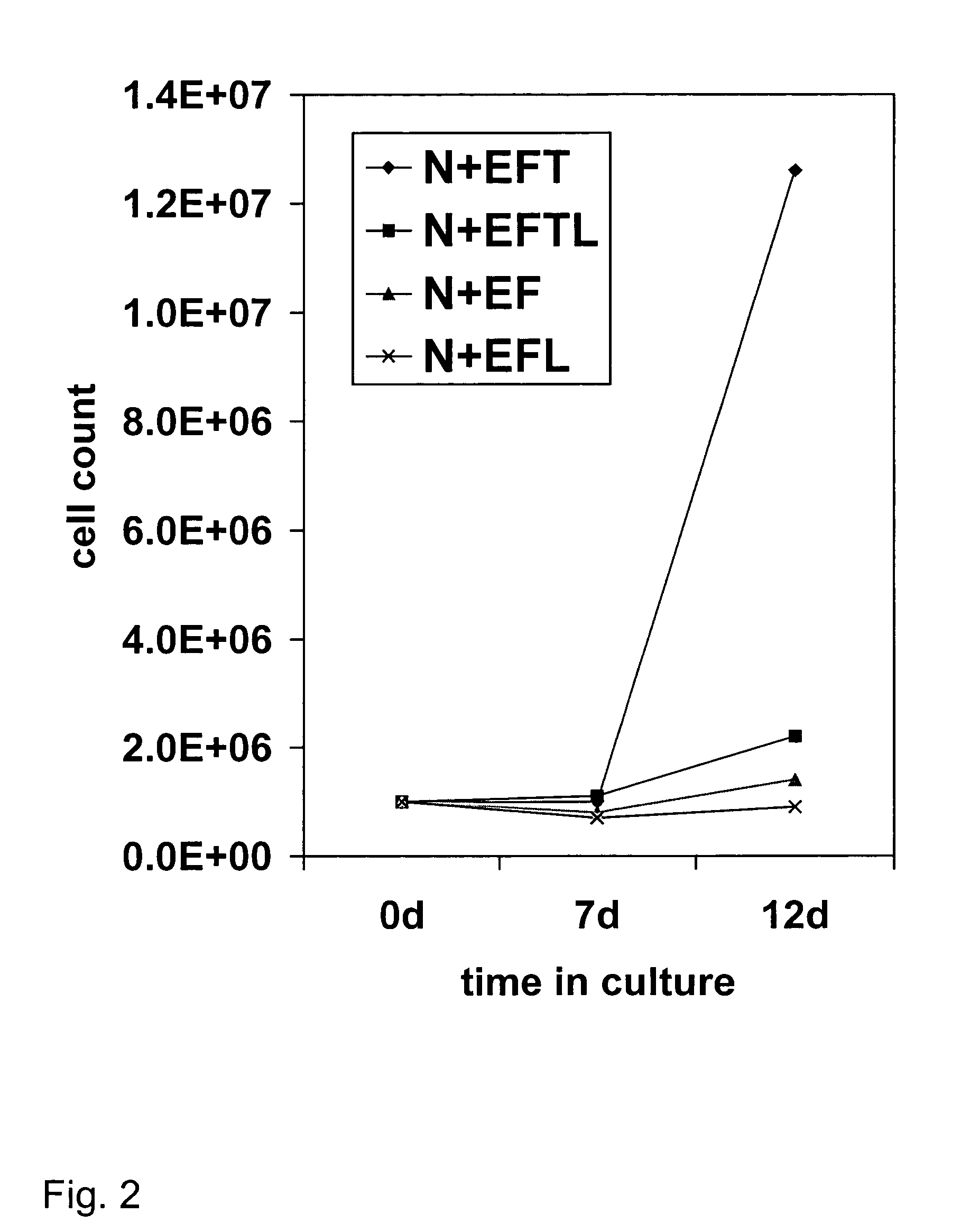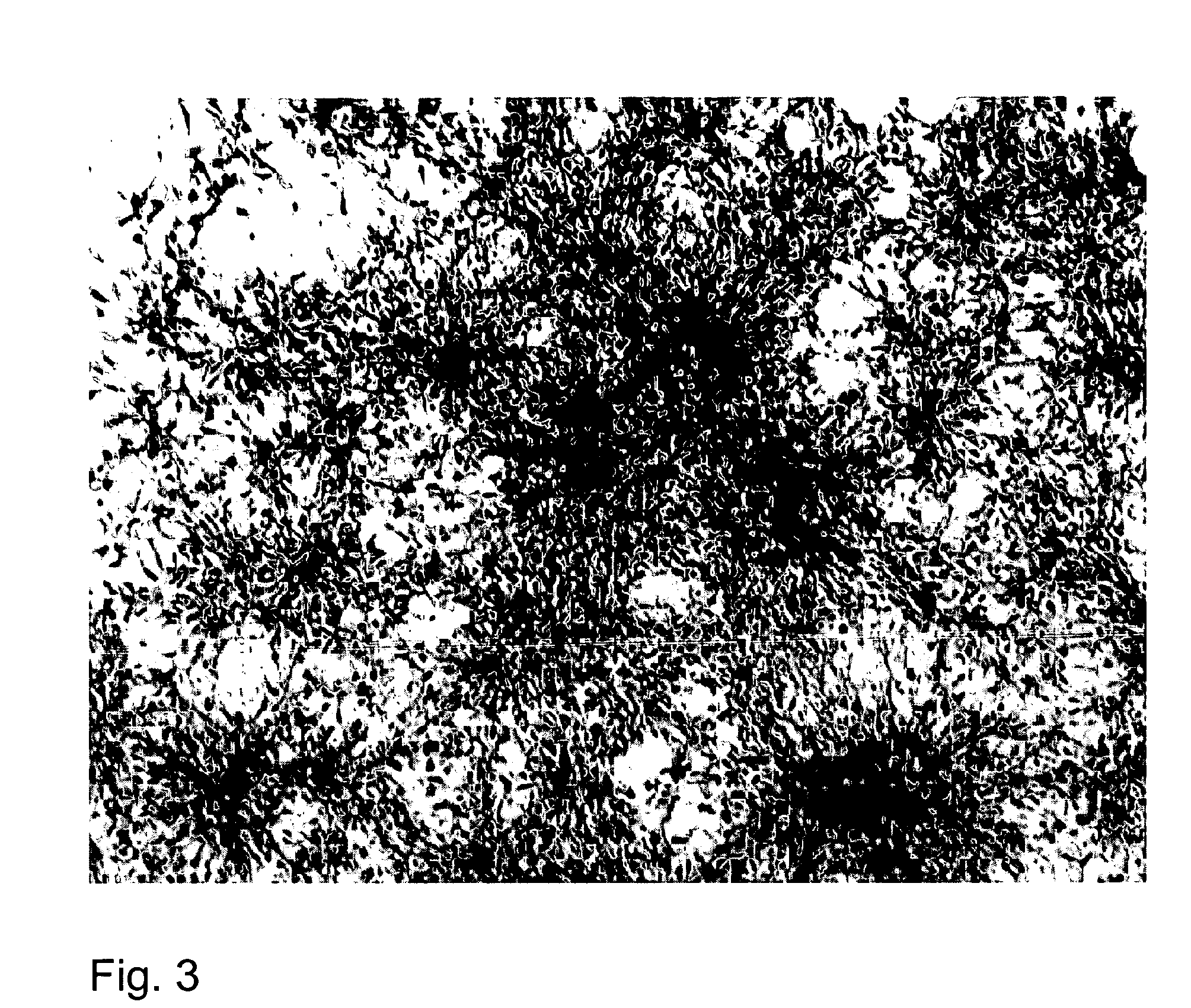Compositions and methods for propagation of neural progenitor cells
a neural progenitor cell and cell technology, applied in the direction of artificial cell constructs, drug compositions, dermatological disorders, etc., can solve the problems of drug-tolerance that develops, the inability of these cells or the relevant brain region to carry out the intended function, and the limited range of drugs capable of crossing the blood-brain barrier. to achieve the effect of increasing prevalen
- Summary
- Abstract
- Description
- Claims
- Application Information
AI Technical Summary
Benefits of technology
Problems solved by technology
Method used
Image
Examples
example 1
Preparation of Progenitor Cells
[0087] This example demonstrates the preparation of brain progenitor cells (BPC), also referred to as neural progenitor cells (NPC). The BPC were derived from the telencephalon (T lines) and mesencephalon (M lines) of fetal brain. Fetal tissue was obtained from physicians in the local area using the guidelines recommended by the National Institutes of Health. The donor was approached with the request for tissue donation only after an elective abortion was performed, and informed consent was subsequently obtained. No monetary compensation or other incentive were offered to the patient, gynecologist, or clinic. A sample of maternal blood was obtained and the following serologic tests were performed: HIV, hepatitis A, B, and C, HTLV-1, VDRL, and CMV. Fetal brain tissue was obtained through a low-pressure aspiration technique under sterile conditions. There was no change in the indication, tuning, or methodology of the abortion between procedures. Fetal t...
example 2
Characterization of Source Tissue
[0089] This example describes the characterization of tissue dissected for the above preparation of BPC. Areas of the fetal brain tissue adjacent to the dissected tissue were treated similarly and fixed for immunocytochemistry and electron- and light microscopy. These adjacent sections were analyzed retrospectively for viability and functional specificity.
[0090] For morphological analysis, cortex and mesencephalon were taken from the fetus and processed for immunocytochemistry or ultrastructural morphology. Following dissection, part of the tissue was fixed in 4% buffered (pH 7.4) PFA fixative, then embedded in paraffin and sectioned on a rotary microtome. Samples of this tissue were processed in a histochemical procedure to visualize the various neuronal and glial markers (AchE, TH, NSE, MAP2, BrDU, Nestin, etc.).
[0091] Immunocytochemical labeling with peroxidase reaction was carried out with antibodies to the glial marker glial fibrillary acidic...
example 2a
Staining for Glial Fibrillary Associated Protein (GFAP)
[0093] Cells were plated onto Superfrost Plus slides using Cytospin® (ThermoShandon, Pittsburgh, Pa.) and then fixed in 4% paraformaldehyde for 20 min at room temperature. The cells were washed twice for 5 min with 1×PBS, pH 7.4 (Gibco). Cells were permeabilized overnight with 70% methanol at 4° C. The cells were washed twice for 5 min in 1×PBS, then blocked for non-specific binding with SuperBlock™ blocking buffer (Pierce Biotechnology, Rockford, Ill.) for 60 mm at room temperature. The SuperBlock was shaken off the slides, and cell preparations were incubated overnight at room temperature with primary monoclonal, mouse derived antibodies to human specific glial fibrillary acidic protein (GFAP) (VectorLaboratories, Inc. Burlingame, Calif.) diluted in SuperBlock™ buffer with 0.1% Triton-X-100. The cells were washed twice for 5 mm in 1×PBS. Cellular endogenous peroxidase activity was blocked with ImmunoPure Peroxidase Suppressor...
PUM
| Property | Measurement | Unit |
|---|---|---|
| concentration | aaaaa | aaaaa |
| temperature | aaaaa | aaaaa |
| temperature | aaaaa | aaaaa |
Abstract
Description
Claims
Application Information
 Login to View More
Login to View More - R&D
- Intellectual Property
- Life Sciences
- Materials
- Tech Scout
- Unparalleled Data Quality
- Higher Quality Content
- 60% Fewer Hallucinations
Browse by: Latest US Patents, China's latest patents, Technical Efficacy Thesaurus, Application Domain, Technology Topic, Popular Technical Reports.
© 2025 PatSnap. All rights reserved.Legal|Privacy policy|Modern Slavery Act Transparency Statement|Sitemap|About US| Contact US: help@patsnap.com



